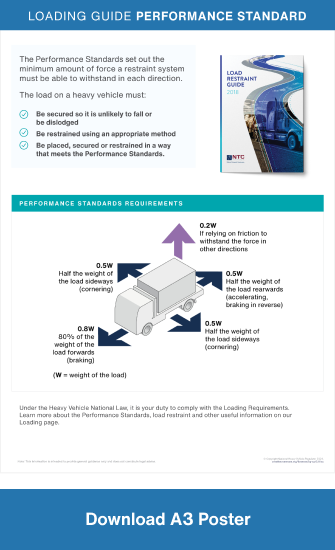Loading Guide - Performance Standards
Loading Guide - Performance Standards
National
Heavy
Vehicle
Regulator
This guide is part of a series of loading guides that provide tips and tricks to help you understand good load restraint.
What are performance standards?
When used in regulations they provide a flexible approach. By stating the minimum requirements that must be achieved, means you have some flexibility on how to meet that outcome, as long as the method used meets or exceeds the performance standards. This means a person or business can choose an approach that best meets their business needs.
For example, braking performance is defined as a stopping distance, or rate the vehicle must be slowed at, not by the size, type, or design of the brakes.
What are the loading performance standards (performance standards)?
The performance standards are the foundation of load restraint requirements. Developed in consultation with industry, transport authorities and road safety experts, they are based on engineering principles and are designed to ensure loads are restrained in a way that minimises the risk of injury or death.
The performance standards are the forces that the load restraint system must be able to withstand in each direction. These forces are what a heavy vehicle typically experiences when accelerating, cornering, and braking.
The performance standards are:
- 0.8g or 80% of the weight of the load forwards
- 0.5g or 50% of the weight of the load sideways and rearwards
- 0.2g or 20% of the weight of the load upwards (If relying on friction to withstand the force in other directions).
The performance standards also cover when movement may be acceptable and options for oversize and overmass (OSOM) vehicles.
The performance standards can be found in:
- Heavy Vehicle (Mass, Dimension and Loading) National Regulation, Schedule 7, Section 2.
- Page 4 of the Load Restraint Guide 2025 (without the OSOM information).
Why are the performance standards important?
The performance standards provide a more flexible approach than prescriptive requirements. This allows you to tailor a load restraint system that best meets the specific needs of your business. The performance standards provide industry and regulators with clarity on what is considered safe and compliant.
How do I know if my load restraint system complies with the performance standards?
The Technical Advice section (page 240) in the Load Restraint Guide 2025 provides users with information and other useful tools that can be used to check if your load restraint system is compliant with the performance standards. These tools are the same used by authorised officers to assess compliance at the roadside.
Where can I get professional advice?
If you’re unsure your load restraint system is safe and compliant, in addition to consulting the Load Restraint Guide, you can seek advice from a suitably qualified engineer or load restraint expert. Professional advice may be especially relevant if you want to design a custom load restraint system for your specific freight task, or you are transporting something unusual or a large indivisible item.

 Accessibility tools
Accessibility tools


